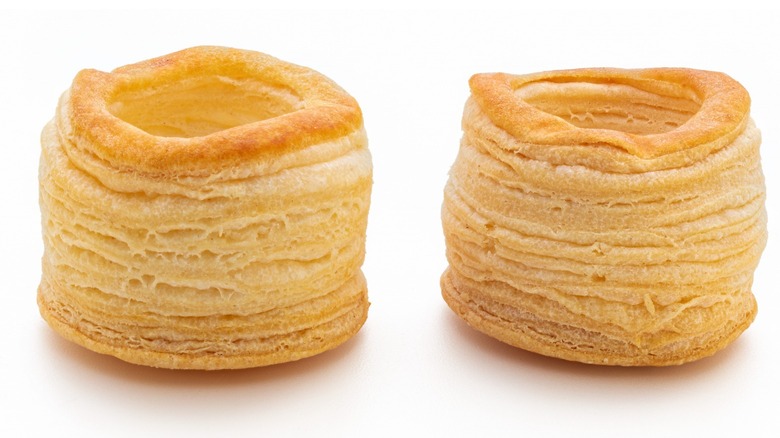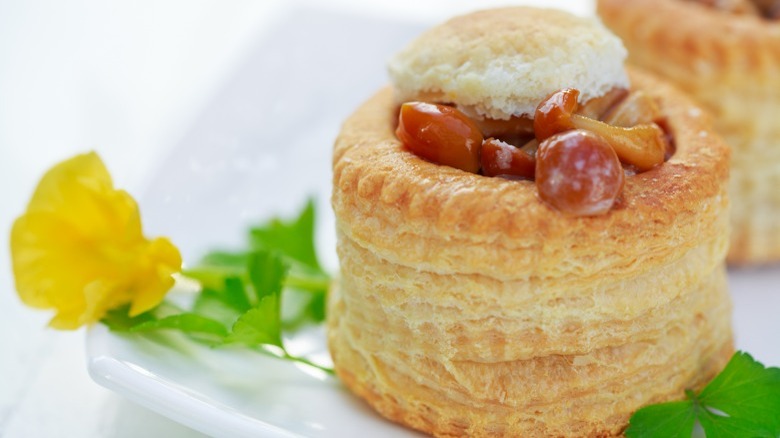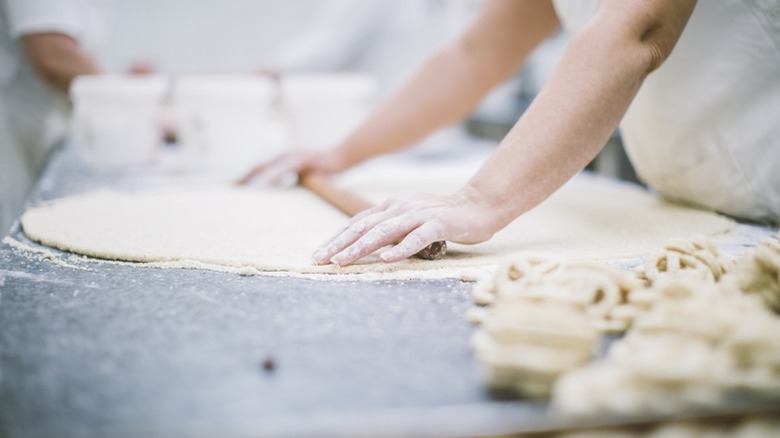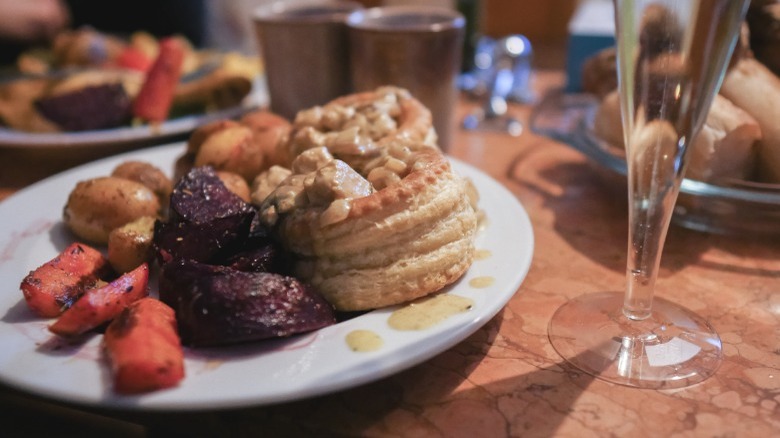What Even Is A Vol-Au-Vent Anyway?
If you're a fan of The Great British Baking Show, you may have heard the term "vol-au-vent" before, but do you actually know what this pastry is and where it comes from? Vol-au-vent translates to "windblown" in French, and fittingly is a French pastry that has both sweet and savory variations. The name comes from the pastry's structure — its stacked layers of pastry are lightweight.
Basically, a vol-au-vent is shaped like a bowl, with circular layers of pastry stacked on top of a base of pastry, and the filling is then added to the middle of the "bowl" after baking. During the 2022 season of The Great British Baking Show, bakers were asked to create sweet vol-au-vent pastries, but they more traditionally have a savory filling. The pastry used is a traditional puff pastry, so it is as buttery as you'd expect a French pastry to be. An authentic French vol-au-vent is filled with a sauce financière, which features ham, mushrooms, thyme, bay leaves, and Madeira wine.
What is a vol-au-vent filled with?
So, what goes inside the pastry bowl? As previously mentioned, a classic vol-au-vent has a sauce financière filling, but there are so many other variations of the hor d'oeuvres that go beyond what you might expect. There are vol-au-vent recipes all over the internet, and many feature unique flavor profiles. One of the most interesting includes curry, hard-boiled egg, and a mango chutney topping. If you want a cheesy twist that is reminiscent of Thanksgiving, you can also make them with brie and cranberry sauce.
Paul and Prue of The Great British Baking Show requested sweet vol-au-vents from their bakers, and there are many filling recipes that trend more towards dessert. One baker on the show went for citrus and created a vol-au-vent filled with mandarin orange cream cheese. Another went for more tropical flavors, including a coconut filling, berry compote, dark chocolate, and strawberries for their vol-au-vent — the possibilities are truly endless.
Is making vol-au-vent easy?
Crafting a vol-au-vent is no easy task, in particular making the puff pastry from scratch. Puff pastry is time-consuming to make even though the only ingredients required are flour, water, salt, butter, and an egg. To begin, you would sieve your flour, then make a well in the middle of it — like a volcano-esque shape — and add the required salt and water to this well. The next step is mixing these ingredients to create a dough which gets formed into a ball and left to sit for 25 minutes.
After this period of sitting, the dough needs to be rolled out. The butter is then added to the middle and covered over by the dough. This sits for 10 minutes, and the final step is called a "tourage," which is a specific method of folding the butter and dough together. Once you've crafted your puff pastry dough, it gets cut into circles to create the vol-au-vent. The first circle is whole, but the next circle has the center cut out and shaped like a donut so that when the pastry bakes, it creates a bowl shape that's ready for filling. The cut out is later used as a lid for the vol-au-vent. There are many different filling options for a vol-au-vent — the pastry is filled with the one of your choosing and covered with the lid.
Where does the vol-au-vent actually come from?
So, where does the vol-au-vent find its origins? It is believed that the vol-au-vent first appeared in the 19th century in a pastry store in France owned by Antonin Carême. As previously mentioned, the classic filling is called a financière, and is actually taken directly from Antonin Carême's book of recipes, titled "L'Art de la Cuisine Française au XIXe siècle". Traditionally, the pastry is served as a hors d'oeuvres or snack, but there is also a Belgian version that is often served as a meal.
The Belgian variation is less of an appetizer and more of a meal that takes the form of a chicken stew. The chicken stew is made using a whole chicken, chicken stock, cream, mushrooms, and meatballs. It's served inside the vol-au-vent pastry, but is also often plated with rice or potatoes. If you're in Belgium and looking to get their version of the French classic, it might appear on the menu in its Dutch form as Koninginnehapje.



